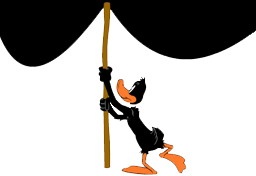In 1953, Warner Bros. produced the now-classic animated short "Duck Amuck," in which an unseen animator does everything in his power to frustrate Daffy Duck. The scenery is constantly erased and redrawn, forcing Daffy from one costume change to the next. At one point, the animator erases Daffy's body and transforms him into a bizarre cross between a lizard and a houseplant. Between all of the frequent scene changes and the numerous instances of Daffy expressing his indignation to both the animator and the audience, "Duck Amuck" is seven minutes' worth of hilarity that's still side-splittingly funny even in today's cynical times. Looney Tunes: Duck Amuck for the Nintendo DS is basically the video game rendition of this classic cartoon. In it, you draw on the touch screen and blow into the microphone to interact with Daffy Duck and play minigame gags meant to torture him, leading to one hilarious animated sequence after another until the poor frustrated duck literally blows his top.

The game opens in unique fashion, with Daffy standing idle on the touch screen, vocally berating you to get his adventure started. From there, you'll discover that tapping Daffy causes him to squirm, drawing the stylus across him cuts him in half, and tapping the white space around him causes various things to happen in the background. For example, swiping a corner of the screen will tear a piece of the background away. In turn, Daffy will react, make a comment about "duck tape," and place a piece of tape over the rip. Pulling the tape away will send Daffy into a wordy tirade and eventually initiate a minigame. Another inspired interaction involves tapping Daffy's body to make an eraser appear. Using the stylus, you then get to erase his body and draw him a new one--which he'll be wearing during the track-and-field minigame that follows.
Figuring out all of the ways you can mess with Daffy and discovering how to initiate minigames is a big part of the game's charm. The truly delightful thing, though, is that the transitions between the interface, minigames, and the recorded animated scenes that play out as a consequence are seamless. You'll tap Daffy and drop an anvil on his head, and he'll pace around delivering a slobbery verbal tirade while the background for the next minigame fills behind him. Once the minigame is done, Daffy will be thrown, smashed, or exploded directly into a 10- or 20-second animated scene showing his unfortunate fate. Afterward, he'll tromp back to the white interface screen where you can return to poking him and get the process going all over again. In total, the cartridge contains a solid 20 minutes' worth of high-quality cartoon clips and recorded voice dialogue. And it's Grade A comedy, too, chock full of references to modern video games and other classic Looney Tunes cartoons.
Unfortunately, while the execution is innovative and delightful, the minigames themselves are a major letdown, both in terms of quality and quantity. Twenty-two different single-player games and three wireless head-to-head games isn't much content when you consider each game lasts five rounds of about 10 seconds each. Worst of all, for every minigame that's genuinely fun and engaging, there are three or four that are just plain garbage. Dropping TNT onto Daffy while he's skiing is amusing, as is the Robin Hood game that involves blowing into the microphone to guide an arrowlike Daffy over obstacles as he sails toward his intended target. Sadly, though, the major share of minigames involve inane things like bouncing generic food items off of walls or rotating arrows to guide an electric current from one side of a maze to the other. It's the sort of drudgery that will irritate you as much as it will our fine feathered friend, Daffy.
Looney Tunes: Duck Amuck is a truly brilliant concept that's almost completely ruined by the limited selection of generally crummy minigames. You'll find yourself smiling quite a bit for the first 30 minutes or so, as you discover all of the ways you can interact with Daffy, uncover new minigames, and watch the different animated sequences unfold. However, once you've seen everything there is to see, you'll probably shut the game off and never feel compelled to play it again. To put it bluntly: "Duck Amuck" works as a seven-minute-long animated cartoon that doesn't cost anything to see, but it fails as a video game because it can't even muster an hour of entertainment for the 30-dollar asking price.